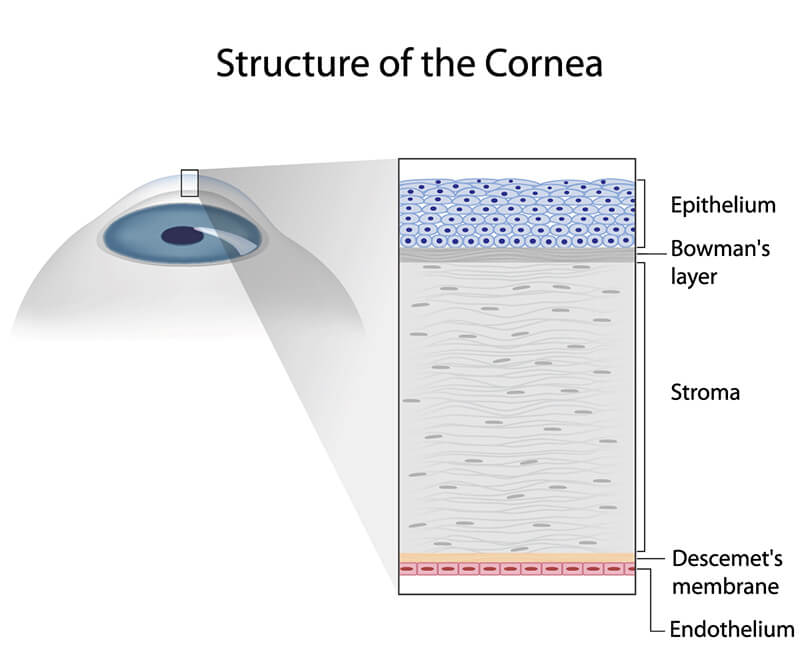 The eye is an amazing organ for its ability to collect visual information from outside the body and transmit it to the brain for us to see the world around us. Although most of the time we have the luxury of taking this complex process for granted, all that changes when eye problems occur.
The eye is an amazing organ for its ability to collect visual information from outside the body and transmit it to the brain for us to see the world around us. Although most of the time we have the luxury of taking this complex process for granted, all that changes when eye problems occur.
In order for light to enter the eye, it must be able to pass through the clear dome on the front of the eye, the cornea. Additionally, the light then has to be focused on the retina and appropriately transmitted to the brain for us to see a clear image.
To do its job appropriately, the cornea needs to have three main characteristics:
- It needs to be clear to allow light to pass through it
- It needs to be the proper shape to help focus light on the retina
- It needs to be the proper thickness to protect the internal structures of the eye
The corneal can be thought of as a sandwich of layers. During your visit, we may discuss problems with these various layers that can be the cause of pain, blurred vision, and either a whitish grey or red appearance of the eye.

As I review these layers, imagine the cornea as being a domed roof.
Epithelium “the shingles of the roof”: This is the outermost layer of the cornea and is thin at just 8 cell layers. The epithelium is like the skin of the cornea. It is very fragile and is constantly being replaced. A scratch or defect in the epithelium causes extreme pain and can make it feel like something is in the eye. The shape of the epithelium defines the shape of the watery tear film. Disruptions in the smoothness of the epithelium and the tear film can dramatically decrease vision.
Bowman’s layer “the felt under the shingles on the roof”: This is the very thin layer on which the epithelium grows. Defects or disruptions of Bowman’s layer often lead to white scars making the cornea less clear. Problems in Bowman’s layer can also lead to problems in the epithelium.
Stroma “the rafters of the roof”: The stroma is the thickest layer of the cornea and is the main structural element of the cornea. Clarity of the stroma is very important. Dense scars in this layer can lead to the need for corneal transplantation. Thinning of the stroma (like a hole in the roof) can be very serious and can threaten loss of the eye.
Descemet’s membrane “the radiant barrier of the roof”: This is another very thin layer on which the endothelium grows. It helps to provide strength and shape to the cornea.
Endothelium “the ceiling tiles of the roof”: This is the innermost layer of the cornea and is just a single cell layer. These cells are arranged like cobblestones on a street and have the job of pumping the water out of the stromal layers. We are born with a set number of these cells and we lose them slowly over time but cannot make more. If the number of these cells drops below a critical amount or they are not functioning properly, the cornea can swell, resulting in corneal edema, decreased corneal clarity, and blurred vision. Severe problems of the endothelium can even lead to blisters in the epithelium and cause pain or a sandy sensation like something is in the eye.
A normally functioning cornea needs to be clear, not swollen, and the correct shape in order for the light to pass through it and be bent into focus on the retina.
Corneal problems that lead to poor vision result in the cornea being cloudy (such that light is blocked), swollen (such that light is scattered), or misshapen (such that light is not focused). In addition to blurred vision, severe eye pain can result.
There are numerous conditions and diseases ranging from trauma, infections, hereditary dystrophies (Fuchs’), ectasias (keratoconus), and previous ocular surgeries that can cause these problems. Treatment for corneal problems can include: artificial tears, medication drops, specialty contact lenses, and surgery.
Common Corneal Conditions Treated by Dr. Vital:
The goal of corneal surgery is usually to restore the clear, thin, and focused characteristics of the cornea. This is achieved by manipulating the existing cornea or replacing it with a corneal transplant.
Are you seeking a Houston eye doctor to identify or treat your corneal conditions? To book a cornea consultation with Dr. Mark Vital, call our office today!


